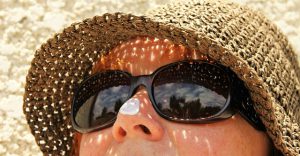As summer heats up and children are out of school, you might be spending more time enjoying the outdoors which means more exposure to the sun’s harmful rays. According to the Center for Disease Control (CDC), skin cancer is the most common cancer in the United States with most skin cancers being caused by ultraviolet (UV) light. UV light is an invisible kind of radiation that comes from the sun, tanning beds, and sunlamps and these UV rays can damage our skin cells. You should protect our skin year-round and not just during the summer months. Be aware that UV rays can penetrate clouds and low temperatures, and can reflect off of surfaces like tile, water, cement, sand, and snow.
Here are some recommendations from the CDC to follow when enjoying the outdoors.

Clothing. Whether going to the beach or a pool, taking a walk or simply running errands, try to wear long-sleeved shirts, long pants, and skirts. If appropriate, try to wear a T-shirt or a beach cover-up as well. The best protection can be provided by clothing made of densely woven material. Darker colors may provide more UV protection than lighter ones, and a damp T-shirt offers far less UV protection than one that is dry. Some clothing has received international certification for providing UV protection.
Hat. For maximum protection, wear a hat that covers your face, ears, and the back of your neck. Avoid loosely woven straw hats. Instead, opt for hats with tightly woven fabric or straw hats with liners. And again, a darker hat will provide better UV defense.
Sunglasses. Sunglasses shield your eyes from UV rays and lessen your chance of developing cataracts. Additionally, they shield the delicate skinsurrounding youreyes from the sun’s damaging effects. The best protection comes from sunglasses that shield UVA and UVB radiation.

Shade. Staying in the shade under a tree, umbrella, or other shelter will lower your risk of UV damage and skin cancer. You should also use sunscreen and wear protective clothing whenever you are outside, even in the shade.
Sunscreen. The ideal sunscreen to choose is a broad-spectrum product that blocks both UVA and UVB radiation and has an SPF of 15 or higher. The sun protection factor is a number used to measure how efficiently a sunscreen blocks UV rays. The higher the number, the more protection you receive. You should also plan to reapply your sunscreen if you are in the sun longer than two hours and especially after swimming, sweating, or toweling off. Additionally, verify the product’s expiration date. In the absence of an expiration date, sunscreen has a maximum shelf life of three years. If it has been exposed to high temperatures, that number falls so try not to store the product in your car.
Check. Familiarize yourself with the signs of skin cancer by examining your skin regularly. Look for any changes in the size, color, or shape of moles or spots and consult a dermatologist if concerned. Early detection of skin cancer can save your life.
Use these recommendations to prioritize your skin health and well-being by incorporating sun protection practices into your daily routine. By implementing these safety measures, you can actively help to minimize the risks of developing skin cancer. The U.S. Environmental Protection Agency (EPA) reported that more than one million cases of skin cancer are reported each year. But while the CDC report focuses on the correlation between sun exposure and skin cancer, it’s essential to strike a balance. Of course, our bodies require vitamin D, which the sun naturally provides. But it’s important to find a healthy balance between sufficient sun exposure for vitamin D and protecting ourselves from excessive UV radiation.
For more information visit:
www.epa.gov/sunwise/uvindex.html
wwwnc.cdc.gov/travel/page/sun-exposure
https://www.epa.gov/sites/default/files/documents/sunscreen.pdf
 1
1

